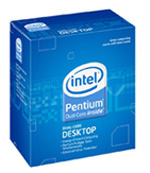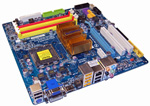Intel HTPC
To be honest, if there's one system in this roundup that is likely to get a lot of comments and criticisms, it's going to be the HTPC configuration. That's not to say that our particular configuration is unreasonable, but in the HTPC market we will invariably encounter a lot of differing opinions about what is necessary and what is not. We detailed our assumptions about the HTPC configurations tin the introduction to the AMD HTPC system. You may want to look back at the considerations. We assume the end user has already selected an HDTV or monitor and a sound system. Very few end users need a TV tuner any more so we are not making that recommendation. We also assume the primary use of the HTPC computer is to play, store, and stream Blu-ray movies and other video entertainment.
| Intel HTPC System | ||
| Hardware | Component | Price |
| Processor | Intel Pentium Dual-Core E5200 Wolfdale (2.5GHz x2 65W 2MB L2 800 FSB) |
$73 |
| Cooling | CPU Retail HSF | $- |
| Video | On-Board | $- |
| Motherboard | Gigabyte GA-E7AUM-DS2H NVIDIA GeForce 9400 | $120 |
| Memory | 4GB DDR2-800 - GSkill F2-6400CL5D-4GBPQ | $37 |
| Hard Drive | Western Digital Caviar Green WD10EACS 1TB SATA 3.0Gb/s Hard Drive - OEM | $105 |
| Optical Drive | LG BD/HD DVD / 16x DVD+/- RW GGC-H20LK | $110 |
| Audio | On-Board | $- |
| Case | Lian LI PC-V350A | $110 |
| Power Supply | PC Power & Cooling Silencer PPCS500 500W ATX12V / EPS12V SLI Ready CrossFire Ready 80 PLUS Certified Active PFC Power Supply - Retail | $50 |
| Base System Total | $605 | |
| Keyboard and Mouse | Logitech Cordless Desktop EX110 Black USB RF Wireless Keyboard & Optical Mouse | $30 |
| Operating System | Microsoft Vista Home Premium OEM | $99 |
| Complete System Bottom Line | $734 | |
 |
As discussed in the Intel entry PC, the E5200 is an excellent value point in the Intel CPU line. Anything lower priced is generally a lot worse in performance, but higher priced CPUs do not gain that much in performance. At the new lower price of $73, the dual-core E5200 is also an excellent match to an NVIDIA 9400 chipset motherboard. It doesn't hurt, either, that the E5200 is rated at 65W, which will help in keeping the HTPC as quiet as possible.
 |
The motherboard for the Intel HTPC is the $135 Gigabyte GA-E7AUM-DS2H featuring the NVIDIA GF9400 chipset. Our motherboard reviews found this chipset and the GF9300 a better choice than G45 in HTPC systems due to superior video playback and overall system performance. Some users have reported that the stock Intel CPU heatsink touches the chipset heatsink on this motherboard and they found the heatsink fit best and worked best by rotating the heatsink 90 degrees. For best results check the fit and best positioning before completing the mount of the heatsink/fan.
 |
The HTPC case is one of those very personal options in building an HTPC computer. Some like the small cube form factor that can easily hide next to books on a shelf, while others prefer the audio component look. While it is fairly expensive for the actual size, we find the cube-like Lian Li PC-V350B a great small aluminum cube. The PC-V350A is the silver version and the PC-V350B is the black version. Both colors sell for the same $110. There is enough space for all the typical HTPC requirements, with good cooling and above all the important blessedly quiet operation. Only a Micro ATX motherboard will fit and there are two 5.25" external drive bays that can open right or left and two internal 3.5" bays for hard drives. Front ports for USB, audio, and FireWire (IEEE 1394) are featured behind a door to keep the appearance sleek and uncluttered. At just 10.3" tall by 11" wide, the V-350A fits in most bookcases just fine, but the depth of 14.7" makes the Lian Li most comfortable on deeper 16" shelves (279mm W x 262mm H x 373mm D).
 |
The little Lian Li is coupled with a robust PC Power & Cooling Silencer 500W power supply that you can currently buy for a bargain $50. You can spend more on a PSU but you will be hard pressed to find a unit as quiet and reliable as the Silencer. It also has enough power for whatever video card you might throw in your HTPC in the future - though high-end GPUs are at odds with the silence most desire from HTPCs.
If you prefer the "audio component" look in your HTPC an excellent alternative is the Silverstone LC13B-E Media Center case selected for the AMD HTPC system. It is worth mentioning that if you choose a full size ATX motherboard for your HTPC, it will fit in the Silverstone but not in the Lian Li cube. The Silverstone is presently on rebate, so the normal $115 price is reduced to $100 after the $10 rebate.
The rest of the components are the same as those found in the AMD HTPC system. For detailed information on the rest of the components chosen for the Intel HTPC please refer to the detailed discussion on the AMD HTPC page.
AMD systems have held the lead for some time in HD video and HTPC boxes. The AMD advantage was large enough that AnandTech hadn't recommended an Intel HTPC build until last December. The NVIDIA GeForce 9300/9400 chipsets have done a lot to level the HD and HTPC playing field - but at a premium price. The Intel HTPC problem was never the CPU, but rather the motherboard chipset. That is the reason we can combine a cheaper Intel CPU with an NVIDIA GF9400 chipset motherboard to create a competent HTPC box.
While we can't tell you HD playback capabilities are completely equal between AMD and Intel today, we can tell you that both HTPC builds provided smooth, stutter-free Blu-ray playback. Certainly that is the primary concern of most HTPC system builders. If you're interested in doing video encoding/transcoding on your HTPC, however, the triple-core Phenom II setup is definitely faster than the E5200; such users would likely want to take a long look at quad-core offerings in all honesty, as encoding is one of the tasks that truly leverage the power of multi-core processors.










66 Comments
View All Comments
7Enigma - Monday, March 16, 2009 - link
I think you're splitting hairs. Both of their Budget systems are fine for gaming if you add in a discrete graphics card. And in both system descriptions they mention adding a graphics card. Reading between the lines means add a graphics card and you have a gaming rig.Pretty simple.
frozentundra123456 - Monday, March 16, 2009 - link
With prices so low, I would say to include a mid-range graphics card such as the HD4670 with any system. The 4670 uses very little power and will improve video and allow decent basic gaming for less than 100.00 additional cost. It seems it is worth this even for the lowest end system which would still cost about 500.00 with monitor and OS and no graphics card.Hrel - Monday, March 16, 2009 - link
You can get a 640GB Hard Drive from Seagate with 32MB of cache, a 7200rpm speed and SATA connection for $60. So, 500GB or 640GB for $60? Hm, tough choice... sarcasm.MrSpadge - Saturday, March 21, 2009 - link
I agree, the systems should have faster HDDs! I'd choose the WD 640 GB 7200 rpm over the Seagate for speed. The WD green power has amazingly tuned firmware and it's faster than many elder 7200 rpm dirves, but it's not a magician and is held back by its 5400 rpm.Just think for a moment what limits the performance of a PC under "normal" use. What happens when you get to an elder machine, even with a healthy windows? Well, if you tell it to do anything you'll be greated by a constant "crrrrrrrr" from the HDD. Not the CPU or GPU is limiting, it's the HDD! That's why going with a 5400 rpm drive is almost silly.. you give up 15 - 20% speed and gain ~3W in power consumption. For the HTPC it's alright though, as it doesn't keep you from working if you have to wait for the HDD.
Hrel - Monday, March 16, 2009 - link
sorry, my bad, that drive is $70 now; it was $60 dollars like week ago though.AntiM - Monday, March 16, 2009 - link
I would say that 85% or more people could get by just fine with these machines. They are perfect for simple office machines. You could probably go even cheaper on the AMD system with an Athlon 64 X2 5600+ and 2 GB or RAM and still have plenty of horsepower for an office machine.Wesley Fink - Monday, March 16, 2009 - link
You can definitely go lower on the AMD CPU, but do you really think anyone would want to pay $67 for a 5600+ or 5600 Brisbane, when they can get a 7750 Kuma Black Edition for $7 LESS at $60. Pricing in entry space can be very strange.I also think dropping RAM from 4GB to 2GB is not very cost effective when you save just $17 by halving the RAM. If every penny counts I guess that that $17 could be important.
AgeOfPanic - Monday, March 16, 2009 - link
With the decoding capabilities of the current IGP chipsets why choose a Phenom processor with higher TDP over a Athlon X2 5050E?Penti - Tuesday, March 17, 2009 - link
A lot of people use homebrew (unlicensed) codecs for warez and their video watching. Those are usually software only or have a limited support for DXVA. Like many alternative media-portal/center software. If you don't want that flexibility there are other devices that even play warez that might fit your bill. But it's only commercial codecs that has decent hardware acceleration. You might also need the power for recording and encoding.7Enigma - Monday, March 16, 2009 - link
I think the answer is, "because we can". Honestly for a true HTPC the last article was fine, and nothing has really changed since then IMO. Yes you can for the same money get a more powerful system or even slightly cheaper, but the HTPC's job is not to be more and more powerful for the same/less money, it's to be cool and quiet while allowing for 1080p and all the resolutions below.Where the latest HTPC systems are beneficial is if you are using the HTPC box to rip or encode to different compressed formats while simultaneously watching something else, and/or recording multiple signals. Then it will be beneficial to have the Phenom II 3-core over a lowly X2.